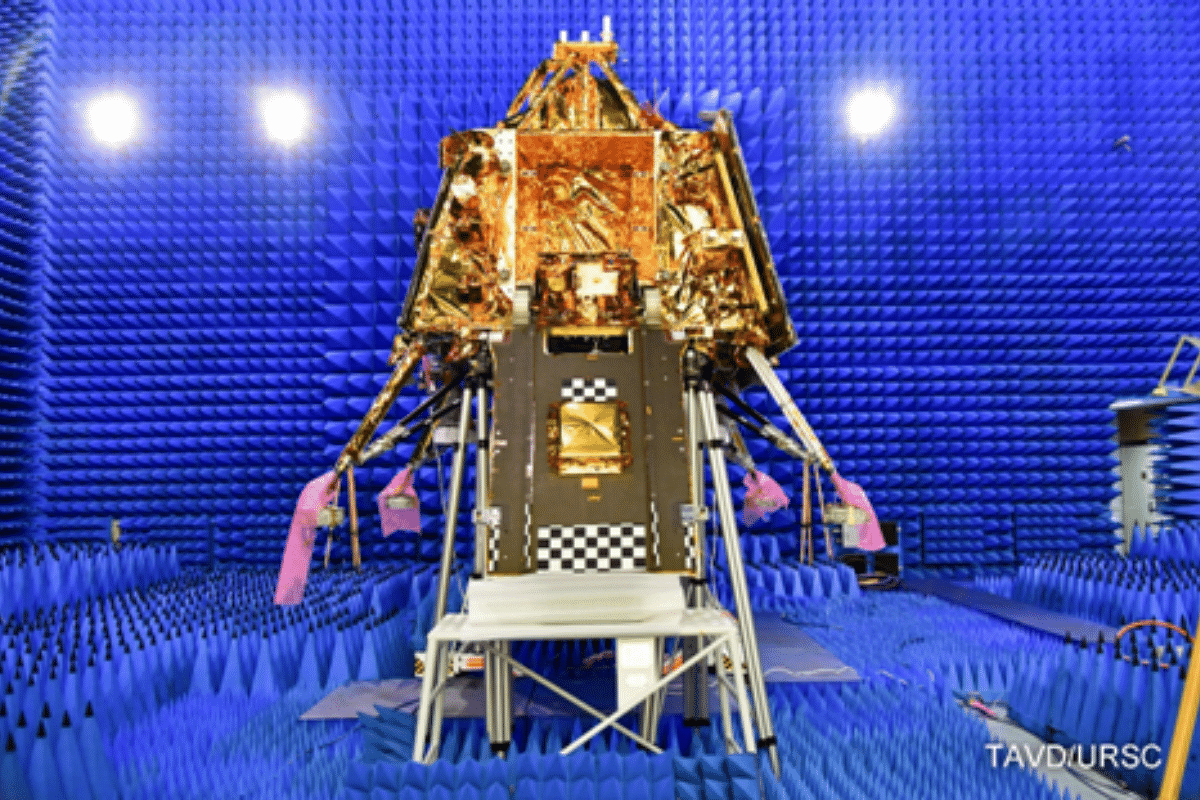Science
Chandrayaan-3: India’s Lunar Lander Clears Critical Test Successfully
- The electrical and electronic systems on a spacecraft have to operate properly in space.
- For that, they have to be guarded against electromagnetic radiation from space as well as from its own, internal subsystems.
- This is roughly what EMI/EMC testing is all about.

The Chandrayaan-3 lander inside the anechoic chamber with various configurations for different tests.(Photo: ISRO).
A test of the lander on India’s upcoming Moon mission, Chandrayaan-3, has thrown a satisfactory result.
The “EMI/EMC test” was held between 31 January and 2 February at U R Rao Satellite Centre in Bengaluru, Karnataka.
“EMI” and “EMC” are short for electromagnetic interference and electromagnetic compatibility respectively.
The electrical and electronic systems on a spacecraft have to operate properly in space. For that, they have to be guarded against electromagnetic radiation from space, as well as, from its own, internal subsystems.
According to Indian Space Research Organisation (ISRO), the EMI/EMC test is conducted to “ensure the functionality of the satellite subsystems in the space environment and their compatibility with the expected electromagnetic levels.”
EMI/EMC testing for space hardware typically includes conducted emissions, conducted susceptibility, radiated emissions, and radiated susceptibility. This is important for space-qualification of spacecraft electronics.
A paper in the IEEE A&E Systems Magazine, published in June 2011, carries an introductory explanation for EMI/EMC testing.
Leo A Mallette and Ray Adams write that the radiated and conducted emissions tests “are used to demonstrate that an electronic unit will radiate RF energy (through the air) and conduct (through the power lines) at levels that will not cause interference to other electronic units on the satellite.”
Further, the radiated and conducted susceptibility tests “are used to demonstrate that radiation (through the air) and conduction (through the power lines) will not corrupt the operation of an electronic unit when normal levels are being emitted from other electronic units on the satellite.”
Why are these two subgroups of testing — conducted and radiated — necessary?
“Spacecraft may experience conducted and radiated EMI from onboard systems or from Electrostatic Discharge (ESD) events caused by spacecraft charging,” the NASA Small Satellite Reliability Initiative Knowledge Base says.
The test’s bottom line is to ensure that the electrical and electronic equipment within a spacecraft function correctly in the environment in which they will operate — space — as ISRO confirms has happened with the Chandrayaan-3 lander.
ISRO has called it “a major milestone in the realization of the satellites.”
The Chandrayaan-3 mission has three major modules — propulsion, lander, and rover. Each of these modules will speak with each other over radio frequency in view of the mission’s complexity.
The propulsion module will communicate with the Indian Deep Space Network (IDSN); the lander module will communicate with IDSN and the rover; and the rover will communicate with the lander.
Systems tested on the EMI-EMC test:
Launcher compatibility
Antenna polarisation of all radio frequency systems
Standalone auto compatibility tests for orbital and powered descent mission phases
Lander and rover compatibility tests for post-landing mission phase
“The performance of the systems was satisfactory,” the Indian space agency said.
Some other lander tests previously completed include the integrated cold test, integrated hot test, and lander leg mechanism performance test.
Chandrayaan-3
Chandrayaan-3 is set to be India’s third Moon mission. It will aim to demonstrate safe and “soft” (controlled) landing and roving on the lunar surface through its lander-rover configuration.
In the process, it will test out technologies required for interplanetary missions, such as altimetres, velocimetres, propulsion; navigation, guidance, and control; and hazard detection and avoidance.
The lander and rover have scientific payloads to carry out experiments on the lunar surface. The rover will carry out in-situ chemical analysis of the lunar surface as it traverses the selected terrain.
The lander and rover will have a mission life of one lunar day, which is roughly 14 Earth days.
The geosynchronous satellite launch vehicle-mark 3 (GSLV Mk3) rocket will launch Chandrayaan-3 from Satish Dhawan Space Centre (SDSC) in Sriharikota, off the coast of Andhra Pradesh.
The launch is expected sometime this year, with June as a likely option.
Support Swarajya's 50 Ground Reports Project & Sponsor A Story
Every general election Swarajya does a 50 ground reports project.
Aimed only at serious readers and those who appreciate the nuances of political undercurrents, the project provides a sense of India's electoral landscape. As you know, these reports are produced after considerable investment of travel, time and effort on the ground.
This time too we've kicked off the project in style and have covered over 30 constituencies already. If you're someone who appreciates such work and have enjoyed our coverage please consider sponsoring a ground report for just Rs 2999 to Rs 19,999 - it goes a long way in helping us produce more quality reportage.
You can also back this project by becoming a subscriber for as little as Rs 999 - so do click on this links and choose a plan that suits you and back us.
Click below to contribute.
Latest